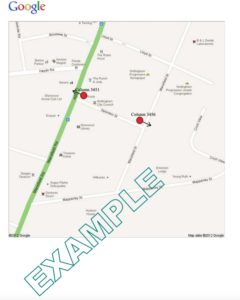- Guidance for Installing Wiltshire Neighbourhood Watch Road Signs
- Obtaining Funds
- General Guidance for Towns
- General Guidance for Villages – Few Lampposts
- Specific Site Risk Assessments (Authority Requirement)
- Designated WNHWA Road Sign Officer
- Processing Your Application For NHW Road Signs & Overlays
- Example of Street Map to Accompany Application
On this page:
If you require street signs for your area/scheme, then contact Rob on his email at: roadsignsofficer@wiltshirenhw.org
There are three types of street signs you can purchase:
- The first one is a sturdy, rigid sign with metal fixings. This sign is the recommended one as it is the one that will last longer and less likely to be vandalised. The cost of these is £35 each. Why not try and see if you can get your local Council or Parish Council to fund these for you or ask your members to give a donation to purchase them.
- The second one is a cheaper one that’s not so good a quaility and is secured by two cable ties. In time they will become brittle and the cable ties will also become loose over time. The cost of these is £10
- The third one is an overlay. What this does is stick over your current sign. The disadvantage of this is that over time the overlay will start to peel off the sign. The cost of these are: £8
So you can see that the first option is the best one if you can get the funding.
Guidance for Installing Wiltshire Neighbourhood Watch Road Signs
There are three steps to ordering Neighbourhood Watch Signs:
- Read through the general guidance on this page.
- Read through the risk assessment requirements.
- Complete and submit the application form.
Obtaining Funds
- Check for adjacent NHW schemes in your area on the website using the postcode search.
- Decide where signs are required to advertise and define your NHW area.
- Seek funds from your local parish council, town council or county council.
- When seeking funding, use the justification that your scheme is helping to create safer communities.
General Guidance for Sign Installation
- Do not fix signs on any wooden telegraph/electricity type pole.
- Avoid all mandatory road signs such as speed limits.
- Avoid all highway signs that already have 2 or more signs on the post(s).
- All other advisory single sign highway signs and bus stop signs, as well as metal lamp posts, can be used if practical.
- Minimum height of signs above pavements is 2.4m above joint walking & cycle paths.
- Use overlays on any existing, but faded or outdated signs, if they are in the right place.
- Seek to place signs on all significant roads entering the area to maximise impact, minimise cost and identify the whole area.
Specific Site Risk Assessments
- The standard Risk Assessment Form may look daunting, but it is common sense and the generic assessment should apply for most site circumstances.
- Check each risk as applied to each site where you wish to position a NHW sign.
- If you are content with the control measures listed for each site, then make sure you follow those measures.
- If you believe other control measures are required or the site chosen is too risky, either:
- Consider changing the site, or
- Add to the control measures for that site, or
- Seek advice from the designated WNHWA Road Sign Officer.
- Sign the Risk Assessment in the space provided and include with your application
Designated WNHWA Road Sign Officer
This is Mr Rob Greenwood (WNHWA Chair & Road Signs Officer).
Either email or post your completed application form, with proposed sites for signs, together with the completed risk assessment to one of the addresses shown on the application form.
Example of Street Map to Accompany Application — Optional
- Find your location on Google Maps.
- Print your local area and add sign information to the map.
- Click the example image to view or download a larger version.
